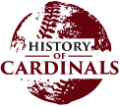1915– The St. Louis Cardinals traded Pol Perritt to the New York Giants for players to be named later. The New York Giants sent Bob Bescher (March 25, 1915) and cash (March 25, 1915) to the St. Louis Cardinals to complete the trade
1998– Long time baseball announcer Harry Caray dies at the age of 84 after suffering a heart attack four days earlier while having Valentine’s Day dinner with his wife, Dutchie. The colorful “Mayor of Rush Street” started his career in 1945 with the Cardinals and also did play-by-play for the A’s, White Sox, and the Cubs during his 52 years in the broadcast booth.
2011- Jim Edmonds at spring training, announced his retirement .
Birthdays
Herm Wehmeier- 1927
Luis Arroyo (February 18, 1927 – January 13, 2016), was a major league baseball pitcher from 1955 to 1963. Arroyo was the first Puerto Rican born baseball player to play for the New York Yankees and and was a key part of their pennant winning seasons in 1961 and 1962.
He was from Peñuelas, Puerto Rico, made his Major League Baseball debut on April 20, 1955. A stocky left-hander, he spent one season primarily as a starter with the St. Louis Cardinals. Though he was a member of the National League All-Star team that year, he was traded to the Pittsburgh Pirates the next spring, where he was moved to the bullpen. Struggling to establish himself in the role, he went from the Pirates to the Cincinnati Redlegs, then the New York Yankees. Arroyo was the first to play for the Yankees, and despite his earlier struggles, he quickly became an important contributor to the club.
Dal Maxvill (born February 18, 1939 in Granite City, Illinois) is a former shortstop, coach and general manager in Major League Baseball (MLB). During his career, Maxvill played, coached, or was an executive for four World winners and seven league champions. A graduate of St. Louis’ Washington University, he earned a degree in electrical engineering. Maxvill signed his first professional baseball contract in 1960 with the hometown St. Louis Cardinals.weak hitter, Maxvill set a number of dubious hitting records in his career. He batted .217 with just six home runs in 3,989 plate appearances over his 14-year major league career. Due to the position he played – and the effectiveness with which he fielded – he was also the beneficiary of the convention that shortstops generally do not need to hit as well as other positions for their skills to be considered assets as Major League players.
Jerry Morales -1949
Marc Hill- 1952
Former Cardinals that Died on this Date
Epp Sell – played for Cardinals 1922-1923 4-3 record with 6.82 ERA in 33 innings
Howie Nunn -2012
Finners Quinlan -1966
